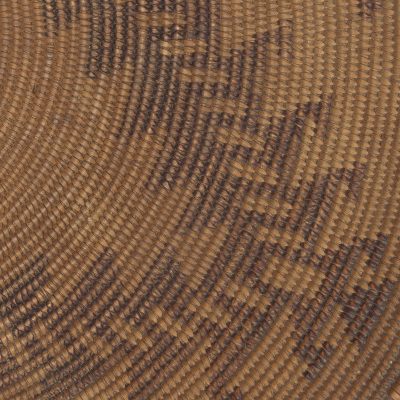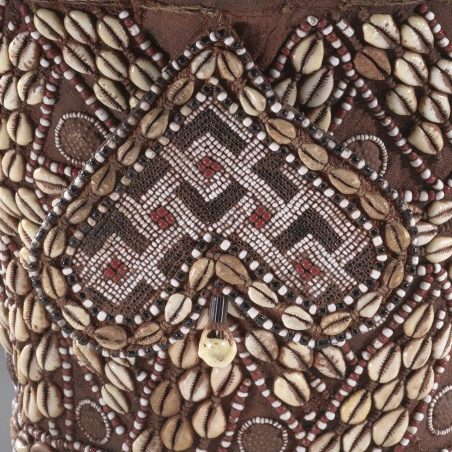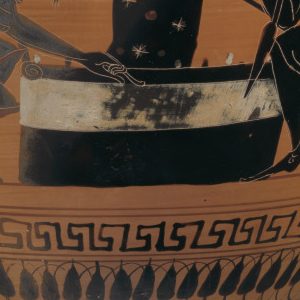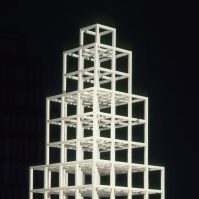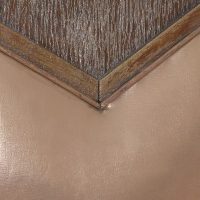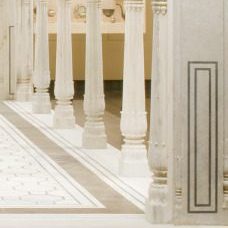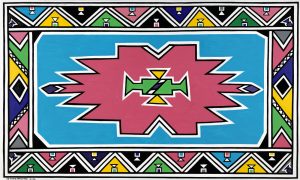
Gallery Hunt: Artistry and Geometry
What do artists and mathematicians have in common? Find these artworks in the VMFA galleries to explore how artistry and geometry work together in fascinating ways!
1.
Native American Art, Evans Court, Level 2
This beautiful coiled basket made by the Maidu people of the Sierra Nevada mountain range features 120-degree rotational symmetry. Can you identify the lines of symmetry? Consider the basket above this one in the case. How is the symmetry similar, and how is it different?
2.
Decorated with intricate floral patterns against geometric designs inspired by textiles, this covered food container would have required great skill to make. Look at how the pattern is organized. What would the artist need to know about a circle to decorate the container’s lid this way? Imagine you were to decorate an object similar to this one. What would be your first step? Where would you go from there?
3.
4.
African Galleries, Level 2
An important part of a Kuba king’s regalia, this object reveals the artist’s mastery of geometric patterning. How many different polygons can you identify in this complex patterning? How do they relate to one another? Can you find examples of congruence or similarity? What about instances of rotation, translation, or dilation?
5.
Ancient Galleries, Level 2
On this Ancient Greek vessel, known as an Amphora, two Trojan heroes play a game while a goddess stands nearby. Framing these figures are patterns characteristic of vases made in ancient Athens. Which patterns do you see that are symmetrical? Ancient Athenians often filled amphora like this one with olive oil and awarded them to victorious athletes. How might we calculate the amount of oil this amphora could hold? What might you need to measure to make a calculated guess?
6.
7.
Once found in the now destroyed Imperial Hotel in Tokyo, this chair was designed by the hotel’s architect, Frank Lloyd Wright. The forms in the chair echo those of the ceiling in the hotel’s Peacock room. Note the back of the chair. How did Wright use line and shadow to make a polygon look like a different three-dimensional shape? What could you do to alter the orientation of this isometric cube?
8.
South Asia Galleries, Level 3
This elegant structure was made in India in the 19th century and once adorned a garden in Rajasthan, India. Here at VMFA, we can admire its beautifully carved white marble and inlaid schist (dark stone) while contemplating the workmanship and artistry needed to erect it. Imagine you were one of the artisans building this pavilion. How might you quickly and accurately decide how many marble octagons to cut for the floor? What information would you need to do your calculations?
Images (as details)
- Artist of Maidu Culture, California, Gambling Tray, 1890, Willow and redbud, Arthur and Margaret Glasgow Fund, 2018.239
- Japanese, Edo Period, Covered Food Container with Floral Design, 18th century, Arita ware; porcelain with underglaze blue and overglaze polychrome enamels, Adolph D. and Wilkins C. Williams Fund, 68.53a-b.
- Esther Mahlangu, ibala leSindebele, 2014, acrylic on linen, Adolph D. and Wilkins C. Williams Fund, 2014.224
- Kuba culture (Democratic Republic of Congo), Kweemishaam’l, Wisdom Basket (translation), 19th – 20th cetury, raffia, cane, cowries, glass beads, copper, Adolph D. and Wilkins C. Williams Fund, 2008.21
- Attributed to the Leagros Group, Greek (Attic), Black-Figure Neck-Amphora, ca. 510 BC, Adolph E. and Wilkins C. Williams Fund, 60.10
- Sol Le Witt, American, 1928-2007, 1 2 3 4 5 6, painted wood, Gift of the Sydney and Francis Lewis Foundation, 85.555
- Frank Lloyd Wright, American 1867-1959 (Designer), Attributed to Matthews Brothers Furniture Company (Woodworkers), Chair (for Imperial Hotel, Tokyo, Japan), oak, upholstery, Gift of Sydney and Francis Lewis, 85.77
- Indian, Rajasthan, Vicinity of Bharatpur, Garden Pavilion, 19th century, white marble with black schist and brown mottled marble inlays, Adolph D. and Wilkins C. Williams Fund, 2005.2
